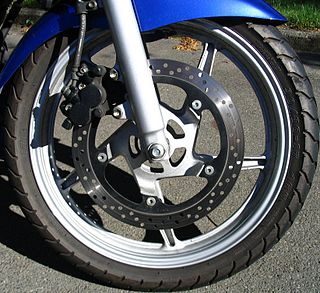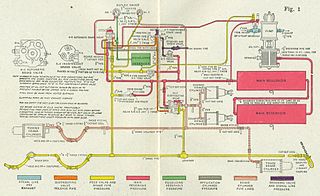
A brake is a mechanical device that inhibits motion by absorbing energy from a moving system. It is used for slowing or stopping a moving vehicle, wheel, axle, or to prevent its motion, most often accomplished by means of friction.

A railway air brake is a railway brake power braking system with compressed air as the operating medium. Modern trains rely upon a fail-safe air brake system that is based upon a design patented by George Westinghouse on April 13, 1869. The Westinghouse Air Brake Company was subsequently organized to manufacture and sell Westinghouse's invention. In various forms, it has been nearly universally adopted.

On trains, the expression emergency brake has several meanings:

Advanced driver-assistance systems (ADAS) are electronic systems that assist drivers in driving and parking functions. Through a safe human-machine interface, ADAS increase car and road safety. ADAS systems use automated technology, such as sensors and cameras, to detect nearby obstacles or driver errors, and respond accordingly.

A signal passed at danger (S.P.A.D.), known in the United States and Canada as running a red light, is an event on the railway where a train passes a stop signal without authority. Where colour light signals are in use, a S.P.A.D. occurs when a train passes a red signal without authority, and where semaphore signals are used, a S.P.A.D. occurs when a train passes a signal in the 'on' position without authority.

The Southall rail crash occurred on 19 September 1997, on the Great Western Main Line at Southall, west London. An InterCity 125 high speed passenger train (HST) failed to slow down in response to warning signals and collided with a freight train crossing its path, causing seven deaths and 139 injuries.

An arresting gear, or arrestor gear, is a mechanical system used to rapidly decelerate an aircraft as it lands. Arresting gear on aircraft carriers is an essential component of naval aviation, and it is most commonly used on CATOBAR and STOBAR aircraft carriers. Similar systems are also found at land-based airfields for expeditionary or emergency use. Typical systems consist of several steel wire ropes laid across the aircraft landing area, designed to be caught by an aircraft's tailhook. During a normal arrestment, the tailhook engages the wire and the aircraft's kinetic energy is transferred to hydraulic damping systems attached below the carrier deck. There are other related systems which use nets to catch aircraft wings or landing gear. These barricade and barrier systems are only used for emergency arrestments for aircraft without operable tailhooks.

In road vehicles, the parking brake, also known as a hand brake or emergency brake (e-brake), is a mechanism used to keep the vehicle securely motionless when parked. Historically, it was also used to help perform an emergency stop should the main hydraulic brakes fail. Parking brakes often consist of a cable connected to two wheel brakes, which is then connected to a pulling mechanism. In most vehicles, the parking brake operates only on the rear wheels, which have reduced traction while braking. The mechanism may be a hand-operated lever, a straight pull handle located near the steering column or a foot-operated pedal located with the other pedals.

The Gare de Lyon rail accident occurred on 27 June 1988, when an SNCF commuter train headed inbound to Paris's Gare de Lyon terminal crashed into a stationary outbound train, killing 56 and injuring 60, resulting as the third deadliest rail disaster in peacetime France.

Vehicular automation involves the use of mechatronics, artificial intelligence, and multi-agent system to assist a vehicle's operator. These features and the vehicles employing them may be labeled as intelligent or smart. A vehicle using automation for difficult tasks, especially navigation, may be referred to as semi-autonomous. A vehicle relying solely on automation is consequently referred to as robotic or autonomous. After the invention of the integrated circuit, the sophistication of automation technology increased. Manufacturers and researchers subsequently added a variety of automated functions to automobiles and other vehicles. The technology involved in implementing autonomous vehicles is very expansive, ranging from technological improvements on the vehicle itself to the environment and objects around the vehicle. As the use of automated vehicles increases, they are becoming more influential in human lives. Although automated vehicles bring various benefits, it also comes with various concerns. Also, there are still technology challenges that autonomous vehicles seek to make a breakthrough in order to make it robust and scalable.
Brake assist or emergency brake assist (EBA) or is a generic term for an automobile braking technology that increases braking pressure in an emergency. The first application was developed jointly by Daimler-Benz and TRW/LucasVarity. Research conducted in 1992 at the Mercedes-Benz driving simulator in Berlin revealed that more than 90% of drivers fail to brake with enough force when faced with an emergency.

Adaptive cruise control (ACC) is an available cruise control advanced driver-assistance system for road vehicles that automatically adjusts the vehicle speed to maintain a safe distance from vehicles ahead. As of 2019, it is also called by 20 unique names that describe that basic functionality. This is also known as Dynamic cruise control.

Vehicle Safety Technology (VST) in the automotive industry refers to the special technology developed to ensure the safety and security of automobiles and their passengers. The term encompasses a broad umbrella of projects and devices within the automotive world. Notable examples of VST include geo-fencing capabilities, remote speed sensing, theft deterrence, damage mitigation, vehicle-to-vehicle communication, and car-to-computer communication devices which use GPS tracking.
Emergency brake can refer to:

A collision avoidance system (CAS), also known as a pre-crash system, forward collision warning system, or collision mitigation system, is a motorcar safety system designed to prevent or reduce the severity of a collision. In its basic form, a forward collision warning system monitors a vehicle's speed, the speed of the vehicle in front of it, and the distance between the vehicles, so that it can provide a warning to the driver if the vehicles get too close, potentially helping to avoid a crash. Various technologies and sensors that are used include radar (all-weather) and sometimes laser (LIDAR) and cameras to detect an imminent crash. GPS sensors can detect fixed dangers such as approaching stop signs through a location database. Pedestrian detection can also be a feature of these types of systems.

During the afternoon rush hour of June 22, 2009, a subway train-on-train collision occurred between two southbound Red Line Washington Metro trains in Northeast, Washington, D.C., United States. A moving train collided with a train stopped ahead of it; the train operator along with eight passengers died, and 80 people were injured, making it the deadliest crash in the history of the Washington Metro.

The Sainthia train collision occurred on 19 July 2010, at the Sainthia Junction railway station in Sainthia, India, when the Uttar Banga Express collided with the Vananchal Express as it was leaving the platform. 66 people died as a result of the accident, and 165 people were reported injured.
City Safety is an auto brake technology that assists in reducing or avoiding traffic accidents at speeds up to 30 km/h (19 mph) in vehicles using City Safety Generation I. Later models using City Safety Generation II can stop at 50 km/h (31 mph). All cars sold by Volvo Cars with a Model Year of 2014 or later is equipped with City Safety Generation II, with an exception of the XC90 (2002-2014). City Safety is made by Volvo Cars. The Volvo V40 was the first car to make use of City Safety Generation II when it was released 2012, and since then other cars in the line up has gotten the same system. It uses lidar laser sensor that monitors an area approximately 6 m (20 ft) directly in front of the vehicle. The feature is programmed to respond if the car in front is either at a standstill or is moving more slowly in the same direction as the car itself. If City Safety determines a collision is unavoidable and the driver does not respond, it activates the vehicle's brakes and switches off the throttle. If the relative speed between the two vehicles is 15 km/h (9.3 mph) or less, a collision may be avoided completely. If the relative speed is above 15 km/h (9.3 mph) and up to approximately 30 km/h (19 mph), the consequences of the collision may be reduced considerably. Keep in mind that these values only applies to City Safety Generation I.
The death of Elaine Herzberg was the first recorded case of a pedestrian fatality involving a self-driving (autonomous) car, after a collision that occurred late in the evening of March 18, 2018. Herzberg was pushing a bicycle across a four-lane road in Tempe, Arizona, United States, when she was struck by an Uber test vehicle, which was operating in self-drive mode with a human safety backup driver sitting in the driving seat. Herzberg was taken to the local hospital where she died of her injuries.

On June 5, 1995, at 6:18 a.m. (EDT), a New York City Subway J train crashed into the back of a stopped M train on the Williamsburg Bridge, which connects Brooklyn and Manhattan in New York City. The motorman of the J train died upon impact and 54 passengers were injured.














